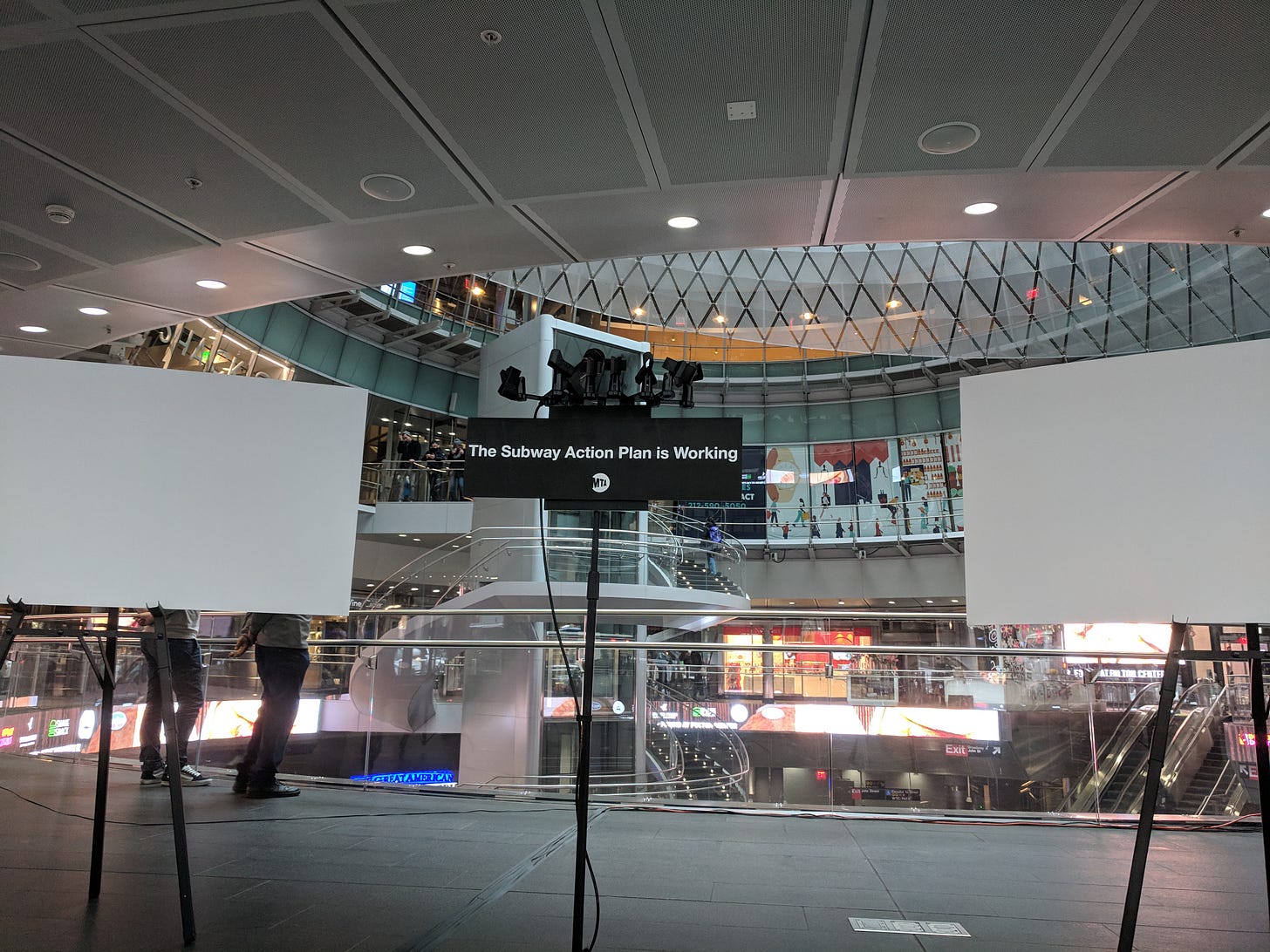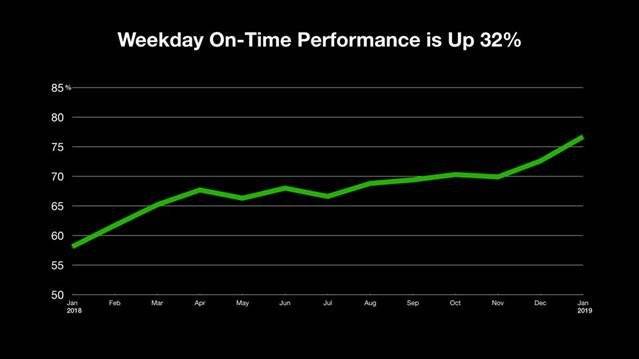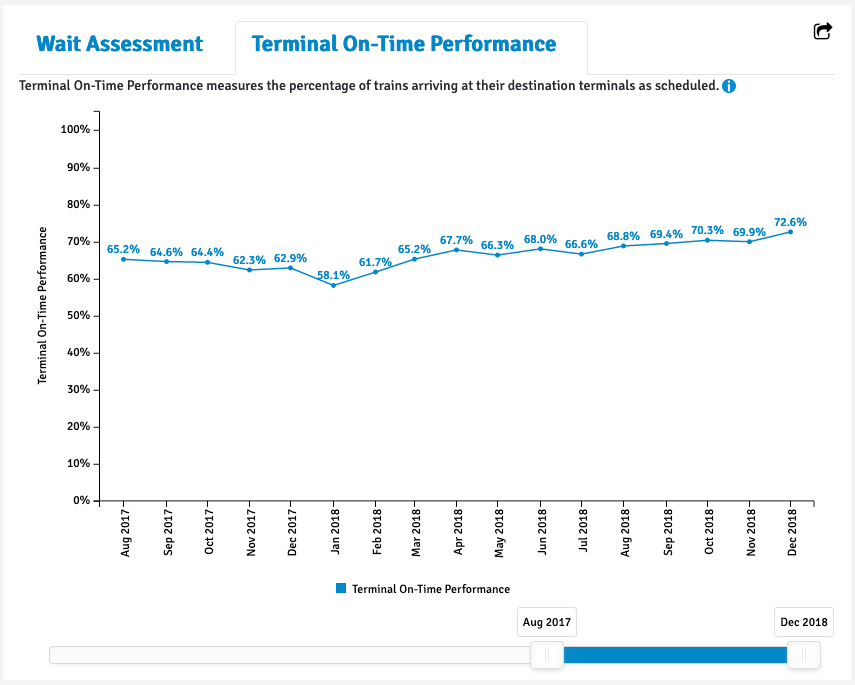The very bad argument for the very good reason to give the MTA more money
The MTA really, really, *really* wants you to think the Subway Action Plan is working.
Just in case there was any confusion what message the MTA wanted us to take away from Sunday’s press conference, they spelled it out for us. Literally. They attached a placard on the podium that read: “The Subway Action Plan is Working.”

Longtime readers of this newsletter will know I do not agree with that statement. I outlined my case in March when I challenged the plan’s entire premise using NYCT’s own internal performance data, in July at the SAP’s one-year anniversary when it was hard to see any improvement, and more recently when subway performance did finally start to improve thanks to NYCT president Andy Byford’s focus on operational basics.
The subway is indeed getting better, of that there is no doubt. But it’s primarily because of Byford’s focus on running the trains better, not because of an $836 million everything-but-the-kitchen-sink approach to infrastructure repair.
As the placard illustrates, the MTA sees it differently. In an accompanying release and Twitter thread, NYCT bragged that weekday on-time performance (OTP) is up almost 30 percent in January since a year ago, delays and major incident statistics similarly impressive. All the statistics illustrated at the press conference and in the release have a one-year time horizon, January 2018 to January 2019.
This choice of time span obfuscates the truth for two reasons. First, the SAP was announced at the end of July 2017, so it throws out the first five months of the plan’s implementation (Governor Cuomo claimed service was improving “if you’re looking very carefully” thanks to the SAP in September 2017, which wasn’t true). Second, January 2018 was an historically bad month for the subway, with an OTP of 58.1 percent and a whopping 76,287 weekday delays. In other words, they picked the absolute nadir as the “starting” point to illustrate the SAP’s efficacy, even though that nadir occurred six months after the SAP was launched.
Indeed, it’s much easier to illustrate your plan is working when your graph looks like this:

than when your graph looks like this:

(The MTA dashboard, where the above graph comes from, hasn’t been updated with January 2019’s stats yet, so you’ll just have to imagine a final point at 76.7 percent.)
Aside from having properly scaled axes, that second graph makes it look like something else started happening around the summer, a full year after the SAP began, that actually improved improve service.
Even more illuminating is how NYCT explained away that horrid January 2018 when those numbers were first released. At the time, NYCT attributed that month’s abysmal performance to bad weather, more unauthorized persons on the tracks, and more sick passengers than normal. Of course, these are classic “external factors” outside of their control on which the SAP has little impact (NYCT had already stationed EMTs around the system to respond to sick passengers more quickly). Tellingly, even during that horrid month of service, NYCT still found a way to argue the SAP was working, by comparing major incidents due to track and signals on a rolling average to prior months.
Notice the contradictory arguments. In January 2018 the SAP was working, they said. But now, that same month is depicted as the literal low point after which the SAP started to work.
All of this makes sense only if your conclusion must always be that the SAP is working. And it’s no mystery why that’s the dynamic at play. The SAP was, after all, “launched at the direction of Governor Cuomo,” as the MTA’s press release Sunday made sure to point out in big, bold font, and Cuomo was the one who put the city on the hook to fund half of it.
Now, the MTA is restricted to telling a very defined story. They want more money to fund the Fast Forward plan, and their best chance of getting it is through congestion pricing, an idea which, to his credit, Cuomo single-handedly revived. In order to get legislators to vote for it, the MTA must among other things demonstrate it can be trusted to spend the windfall wisely. That requires justifying the SAP’s $836 million expense, something they can only do because of performance improvements thanks to Byford’s Save Safe Seconds campaign, which cost essentially nothing—and is nowhere to be found on the aforementioned press releases.
It’s so deliciously ironic. The MTA is using the very real benefits of an effective, costless program to defend an expensive, inefficient plan, all so it can further argue it can be trusted with more money. Yet, it is the very program they are trying to gloss over, the one that’s actually making the trains run better, that’s their best argument for giving them more money.
In a more rational universe without all this irony, Sunday’s press conference could have been different. Byford would have told the assembled media about Save Safe Seconds, the SPEED Unit, and his other successful programs to make the subway better without asking for any money at all. The era of throwing money at the problem and hoping something stuck was over, he might have said. But there are specific, necessary improvements that will cost money, such as making the system accessible and upgrading the signals. But we can trust him with that money, he might have said, to spend it wisely and well, because he is ushering in a new era of efficiency. A focus on the basics.
Back in May, when Byford released the Fast Forward plan, of the most frequently asked questions by the media, politicians, and the public was why the MTA should be trusted with billions of dollars more, considering their propensity of wasting many of the billions they’ve gotten in the past. In this other universe, one Sunday made very clear we don’t inhabit, he might have been able to tell us why.


